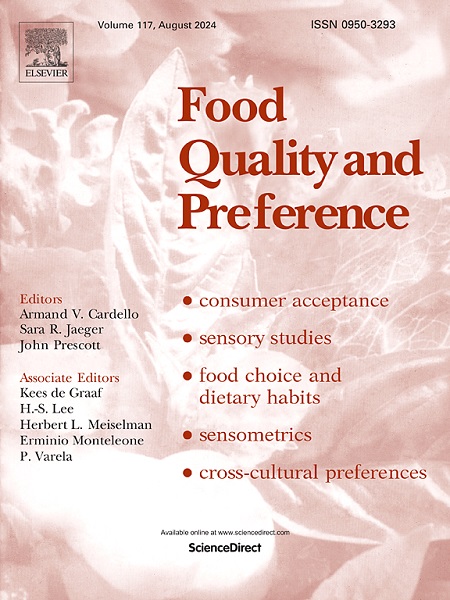欧洲消费者对日期标签的参与及其对家庭食物浪费的影响
IF 4.9
1区 农林科学
Q1 FOOD SCIENCE & TECHNOLOGY
引用次数: 0
摘要
食品浪费(FW)在欧盟仍然是一个重大挑战,每年产生超过5800万吨。消费者行为,特别是与食品日期标签有关的行为,是影响食品安全的关键因素。本研究聚焦于日期标签的参与模式,考察不同消费者群体对日期标签的理解、注意和行为反应是如何变化的。通过基于这些维度的消费者聚类,本研究旨在识别不同的日期标签参与模式及其对FW决策的影响。该研究涉及来自6个欧盟国家(比利时、法国、德国、意大利、西班牙和瑞典)的1507名消费者(54.6%为女性,平均年龄44.9岁)。参与者完成了一份在线问卷,评估他们对日期标签的理解、注意力和行为反应,以及他们报告的家庭FW行为、社会人口统计学和FW管理技能。结果表明,75.2%的欧洲消费者了解“在此之前使用”和“最佳食用”日期之间的区别,超过80%的消费者正确识别这些术语的含义。加深了解与减少家庭FW相关,但仅凭这一因素不足以显著降低废物水平。此外,增强日期标签的使用在最小化FW方面起着至关重要的作用。该研究确定了不同的消费者群体对日期标签的偏好:“高参与”群体(23.9%),他们依靠日期标签来管理食品;“低参与”群体(33.4%),他们根据其他因素(如感官线索)做出决定;“中等参与”群体(42.6%),表现出中间特征。这种细分为设计有针对性的干预措施提供了有价值的见解,旨在改善日期标签的使用和减少家庭FW。本文章由计算机程序翻译,如有差异,请以英文原文为准。
European consumers' involvement with date labels and implications for household food waste
Food waste (FW) in the European Union remains a significant challenge, with over 58 million tons generated annually. Consumer behavior, particularly in relation to food-date labels, is a key factor influencing FW. This study focuses on patterns of involvement with date labels, examining how understanding, attention, and behavioral responses to date labels vary across consumer segments. By clustering consumers based on these dimensions, the research aims to identify distinct involvement patterns toward date labels and the impact on FW decisions.
The study involved 1507 consumers (54.6 % female, mean age = 44.9 years) from six EU countries (Belgium, France, Germany, Italy, Spain, Sweden). Participants completed an online questionnaire assessing their understanding, attention, and behavioral responses to date labels, alongside their reported domestic FW behaviors, sociodemographics, and FW management skills.
Results indicate that 75.2 % of European consumers understand the difference between ‘use by’ and ‘best before’ dates, and over 80 % correctly identify the meanings of these terms. Increased understanding correlates with reduced household FW, but this factor alone is insufficient to significantly lower waste levels. Additionally, enhanced use of date labels plays a crucial role in minimizing FW.
The study identifies distinct consumer segments toward date labels: “Higher involvement” segment (23.9 % of subjects), who rely on date labels for food management, “Lower involvement” segment (33.4 %), who base their decisions on other elements such as sensory cues, and “Medium involvement” segment (42.6 %), which shows intermediate characteristics. This segmentation provides valuable insights for designing targeted interventions aimed at improving date label usage and reducing household FW.
求助全文
通过发布文献求助,成功后即可免费获取论文全文。
去求助
来源期刊

Food Quality and Preference
工程技术-食品科技
CiteScore
10.40
自引率
15.10%
发文量
263
审稿时长
38 days
期刊介绍:
Food Quality and Preference is a journal devoted to sensory, consumer and behavioural research in food and non-food products. It publishes original research, critical reviews, and short communications in sensory and consumer science, and sensometrics. In addition, the journal publishes special invited issues on important timely topics and from relevant conferences. These are aimed at bridging the gap between research and application, bringing together authors and readers in consumer and market research, sensory science, sensometrics and sensory evaluation, nutrition and food choice, as well as food research, product development and sensory quality assurance. Submissions to Food Quality and Preference are limited to papers that include some form of human measurement; papers that are limited to physical/chemical measures or the routine application of sensory, consumer or econometric analysis will not be considered unless they specifically make a novel scientific contribution in line with the journal''s coverage as outlined below.
 求助内容:
求助内容: 应助结果提醒方式:
应助结果提醒方式:


